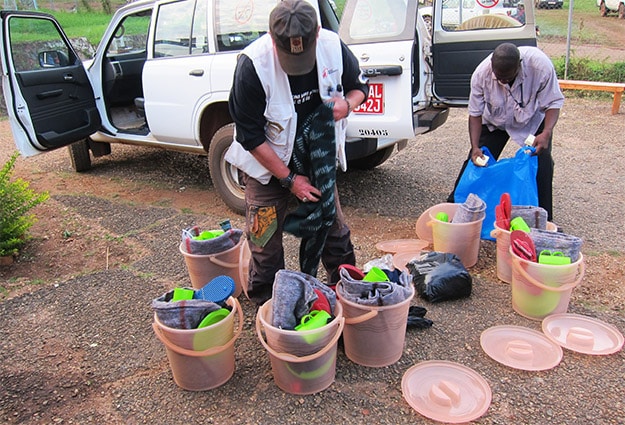Responding Faster than Ever in the Hot Zone
February 28, 2018

A member of Doctors Without Borders (left) and a Ugandan health worker prepare kits for Ebola survivors to take home upon discharge from the hospital.
Public Health Threat:
Uganda is a “hot zone” for infectious diseases. Without the ability to quickly detect and respond to threats, a local outbreak could spiral into global crisis.
Response:
With support from CDC and partners through the Global Health Security Agenda, Uganda is responding faster than ever to contain outbreaks at the source. The country’s national public health emergency operations center (PHEOC) coordinates strong surveillance and response systems that work hand-in-hand to tackle emergencies.
- Multi-level surveillance systems watch for alerts and monitor information in real-time
- A strong and efficient in-country laboratory network accurately identifies threats within hours
- A national system gets samples to labs from anywhere in the country in 1-2 days
- A trained workforce, including a National Rapid Response Team and FETP-trained disease detectives, can deploy quickly anywhere in the country
- A National Task Force stands ready to take direct action
- Collaboration and partnership with national and international stakeholders builds capacity and ensures efficient use of resources
Impact:
Deadly outbreaks in Uganda have included viral hemorrhagic fevers (Ebola, Marburg, yellow fever, Rift Valley fever, and Crimean-Congo hemorrhagic fever), cholera, meningitis, plague, and anthrax, among others.
Newly emerging viruses have been discovered in Uganda, and the threat remains for re-emergence of pathogens like West Nile virus and Zika. In 2017, Uganda saw its first cases of highly pathogenic avian flu in migratory birds from Europe.
Uganda is particularly vulnerable to epidemics because of its unique location near the Congo Basin; its close connection with other countries; the risk from natural disasters; and the ever-present threat of evolving pathogens or antimicrobial resistance.
The important work being done in Uganda has dramatically reduced the time it takes to detect and respond to outbreaks. While it took over 40 days to confirm a 2010 yellow fever outbreak through outside laboratories, global health security improvements enabled Uganda to detect and confirm a 2016 outbreak in-country in only 10 days. Today, the country responds even faster – usually within 1-2 days.
In November 2017, Uganda staged a rapid and effective response when three deadly cases of Marburg Virus Disease were reported in Eastern Uganda. CDC Uganda assisted with tracing, monitoring, and testing of 297 people in Kween and Kapchorwa Districts who had been in contact with sick patients. One suspected case traveled across the border into Kenya, raising additional concerns about the virus spreading; CDC Kenya supported emergency preparedness activities to prevent a potential outbreak there.
CDC also participated in a mobile laboratory deployment exercise in Kapchorwa Hospital in preparation for future Marburg or Ebola outbreaks. This exercise was supported by the Global Outbreak Alert and Response Network and coordinated by WHO with support from the European Mobile Lab Project and Médecins Sans Frontières. This outbreak further demonstrated the need for the international community to work closely together to ensure rapid and effective response to disease threats.